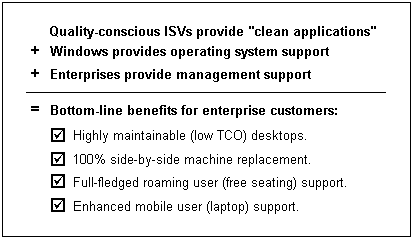
[This is preliminary documentation and subject to change.]
Application software is increasingly being used in large enterprises, where customer requirements are different from those of individuals who do not depend on a network.
To radically reduce the total cost of ownership (TCO) for desktops running Microsoft® Windows NT® Workstation 5.0 in large organizations, it is essential to create applications that can be easily deployed and maintained by an administrator, rather than asking the user to deal with such complexities. In the "no touch" management paradigm, administrators should be able to deploy applications to any number of users in a few simple steps. Administrators should be able to customize these applications, so that users receive precisely the components they need. Administrators should be able to update applications easily — it should only require a few simple steps to upgrade a group of users to a new version of an application.
For users, application installation should become virtually transparent. Key applications should always be available, even when a user roams from computer to computer, or works offline on a laptop. If a user encounters a file with an associated application that is not within his or her user profile, that application should be automatically loaded, without the user being asked to figure out what application is needed. Application updates occur automatically, without the need for users to intervene. Finally, if a user's computer fails, it should be possible simply to plug in a replacement and have all the user's settings and data automatically restored.
Windows NT Workstation 5.0 addresses these kinds of software management problems that large enterprises face, and gives you the tools to solve them.
Using those tools and incorporating those solutions in your product may require a significant investment of development time on your part, but the payoff more than justifies the effort. In today's highly competitive market, support for Windows NT 5.0 infrastructure technologies offers an extraordinary opportunity to distinguish your product from the competition, with features that a wide spectrum of corporate buyers have identified as crucial to their buying decisions.
The formula is straightforward:

What's more, following the guidelines for writing "clean" applications will help your application qualify for the Designed for Microsoft® Windows® Logo, another strong selling point in the enterprise marketplace.
The following sections discuss what your development team needs to do to make your product a "clean application" suited for deployment in a large enterprise.
For more information about all the new Windows NT 5.0 technologies that can help you meet enterprise needs, see http://www.microsoft.com/windows/zaw.